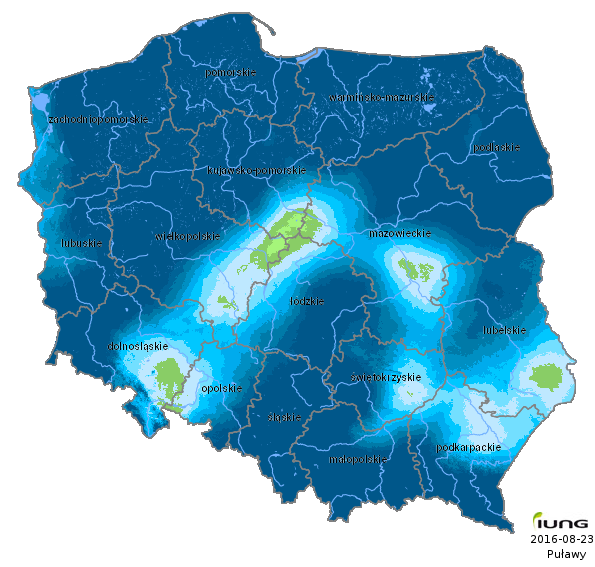ARCHIVES (2016)
Do roku 2016 raport oznaczony numerem 1 był tworzony za okres od 1 kwietnia do 31 maja. Od roku 2017 analizy są wykonywane o dekadę wcześniej czyli 1 raport oznacza okres od 21 marca do 20 maja
Communication report regarding the incidences of drought conditions in Poland
Year: 2016; period: 09 (21.VI - 20.VIII)
The Institute of Soil Science and Plant Cultivation – State Research Institute, in accordance with an Act from the Minister of Agriculture and Rural Development has developed the climatic water balance for all 2478 Polish local districts and, on the basis of soil categories, calculated the current risk of agricultural drought for the following crops: grain maize and maize for silage, potato, sugar beet, hops, tobacco, ground vegetables, fruit shrubs and trees, and legumes.
In the ninth reporting period, i.e. from June 21 to August 20, 2016, IUNG-PIB stated no risk of agricultural drought conditions in Poland. The Climatic Water Balance values, which are the basis for assessing the risk of agricultural drought, are negative for the majority of areas. However, for the aforementioned crops the values are higher than critical.
In this reporting period the lowest Climatic Water Balance values have been recorded in the south-eastern part of the Lubelska Upland (Roztocze) and the Małopolska Upland, south-eastern part of the Mazowiecka Lowland, and in the southern part of the Silesian Lowland. At present, the lowest Climatic Water Balance values in these areas range from -109 to -139 mm.
In the current sixty-day period the Climatic Water Balance values in Poland have decreased, on average, by 12 mm in comparison to the previous reporting period.
The air temperature in June this year was higher by 1°C than the multiannual average in the vast majority of areas. The maximum variation of the monthly average was recorded in the area of Wrocław (2°C). June was warm in the whole country. In the majority of the Polish territory the recorded temperature ranged from 19°C do 20°C. Slightly lower temperature (18°C-19°C) was recorded in the Pomeranian and the Mazurskie Lake Districts, in the southern part of the Północnopodlaska Lowland and in the Kielecka Upland. The lowest temperature was recorded in the Bytowskie Lake District and in the western part of the Mazurskie Lake District, where it ranged from 17°C to 18°C.
The temperature distribution in the first decade of August was similar to July. The lowest temperature, below 16.5°C, was recorded in the Pomeranian Lake District, in the south-west Sudeten and in the Tatra Mountains. It was warmer in the Mazurskie Lake District and in the Małopolska Upland (17.5°C-18°C). The highest temperature, above 19.5°C was recorded in the south-eastern part of the Lubelska Upland and in the Opolska Plain. In the rest of the country temperature ranged from 18.5°C to 19.5°C.
The second decade of August was colder. The lowest temperature, below 15°C was recorded in the Suwalskie Lake District, in the central part of the Północnopodlaska Lowland, in the Sudetes, the Beskids and the Tatra Mountains. The highest temperatures, from 16.5°C to more than 17.5°C occurred in the central part of the Silesian Lowland, in the Południowowielkopolska Lowland, in the Lubawskie Lake District, and in the Mazowiecka Lowland. In the vast majority of the country the air temperature ranged from 15°C to 16.5°C.
Precipitation in June widely varied across the country due to the stormy character of rainfalls. The lowest precipitation (below 60 mm) occurred in the western part of the Pomeranian Lake District, in the Szczecińskie Coastland, in the Mazowiecka Lowland, the Silesian Lowland, and in the Tarnowski Plateau, constituting 80-100% of the multiannual norm. In the rest of the country precipitation ranged from 80 to 160 mm. In the area of Toruń and the Białostocka Upland precipitation ranging from 180 to 200 mm occurred (constituting 200-240% of the multiannual norm). The highest precipitation (220-260 mm, and here and there exceeding 260 mm) was recorded in the southern part of the Krakowsko-Częstochowska Upland, in the Beskids and in the Tatra Mountains. It constituted 220-240% of the multiannual norm.
In the first decade of August a highly diversified precipitation was recorded. Precipitation below 10 mm occurred in the Silesian Lowland and in the southern part of the Południowowielkopolska Lowland. In the majority of the country precipitation ranged from 20 to 40 mm. The highest values, between 40 and 80 mm, and here and there exceeding 80 mm were recorded in the Koszalińskie Coastland, the Beskids, the Tatra Mountains and in the Małopolska Upland.
The second decade of August was also characterised by great variations in precipitation. In the vast majority of the country precipitation did not exceed 5 mm. A slightly higher precipitation (20-40mm) was recorded in the northern part of the Pomeranian Lake District and the Mazurskie Lake District, in the Lubuskie Lake District and in the Przemyskie Foothills. The highest precipitation values ranging from 40 to 60 mm were recorded in the Koszalińskie Coastland and in the Górowskie Uplands.
Weather conditions during the recent weeks characterised by heavy and stormy rainfalls may cause difficulties in harvest, particularly for spring rape. The problem results from an uneven ripening of the crops susceptible to create lateral shoots with delayed maturation of grains. These adverse phenomena may cause a reduction of spring rape yield.
Report prepared by:
Dr hab. Andrzej Doroszewski, associate professor
Dr hab. Rafał Pudełko
Dr Katarzyna Żyłowska
Mgr Piotr Koza
Mgr Elżbieta Wróblewska
……
Reports
- Report 13 (1.VIII - 30.IX)
- Report 12 (21.VII - 20.IX) +
- Report 11 (11.VII - 10.IX)
- Report 10 (1.VII - 31.VIII)
- Report 09 (21.VI - 20.VIII)
- Report 08 (11.VI - 10.VIII)
- Report 07 (1.VI - 31.VII)
- Report 06 (21.V - 20.VII)
- Report 05 (11.V - 10.VII) +
- Report 04 (1.V - 30.VI) +
- Report 03 (21.IV - 20.VI) +
- Report 02 (11.IV - 10.VI) +
- Report 01 (1.IV - 31.V) +





